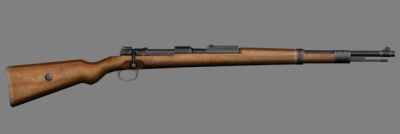Difference between revisions of "Karabiner 98k"
(Created page with "{| class="wikitable floatright" | colspan="2" | 400px |- style="background:#666600; color:#fff;" | colspan="2" style="text-align: center;" | '''Karabine...") |
|||
| Line 1: | Line 1: | ||
{| class="wikitable floatright" | {| class="wikitable floatright" | ||
| colspan="2" | [[File:In_de_k98.jpg|400px]] | | colspan="2" style="text-align: center;" | [[File:In_de_k98.jpg|400px]] | ||
|- style="background:#666600; color:#fff;" | |- style="background:#666600; color:#fff;" | ||
| colspan="2" style="text-align: center;" | '''Karabiner 98k Mauser''' | | colspan="2" style="text-align: center;" | '''Karabiner 98k Mauser''' | ||
Revision as of 17:39, 21 November 2014

| |
| Karabiner 98k Mauser | |
| Specifications | |
| Type | Bolt-action rifle |
| Caliber | 7.92 mm |
| Feed System | 5-round clip |
| Muzzle Velocity | 745m/s |
| Maximum Effective Range | 800m |
The Karabiner 98k (often abbreviated Kar 98k or K 98k) was a bolt-action rifle adopted as the standard infantry rifle by the Wehrmacht, and was one of the final developments in the long line of Mauser military rifles.
In 1898, Mauser introduced a fine bolt-action rifle, the Gewehr (Rifle) 98 that Germany adopted and used in World War I. It used a Mauser-type action and held five rounds of 7.92x57mm (also known as 8mm Mauser) ammunition on a stripper clip, loaded into an internal magazine.
After the war, the Wehrmacht decided to modify the rifle. Although the Wehrmacht desired a shorter and less bulky gun, the new version, the Karabiner (Carbine) 98b, despite its name (a carbine is a short-barreled gun) was the same length as the Gewehr 98 and incorporated only some fairly minor changes.
By the time Germany invaded Poland, the Kar 98b had at last shrunk a little. The 140mm (5.51in) shorter and otherwise improved rifle was based on a commercial Mauser design called the Standard Model (Standard Model), and in military service was known as the Karabiner 98k (the “k” stood for kurz, meaning “short”). Even though it was called short, it was still fairly long for a carbine.
The 98k went into production in 1935, and served throughout World War II as Germany’s standard rifle. During the war, factories churned out huge quantities of 98ks which proved to be reliable and accurate arms. Due to shortages of raw materials, time, and skills, the aesthetic appearance of the guns deteriorated as the war went on. The expensive wooden stock and other wooden parts were replaced with laminated wood, and the finish grew rougher.
The German soldier prized his 98k for its accuracy. The 98 family of guns featured a light action that promoted sure shooting, although at the expense of speed - a Lee Enfield could get off more shots per minute. The 98k’s V-shaped rear sight marked off ranges from 100 m (109 yd) to 2,000 m (2,187 yd).
The Germans introduced various types of extras, including periscope and telescopic sights, and folding butts for airborne troops. The 98k acquired the ability to launch rifle grenades in 1941. The weapon is still in production today as a sporting rifle.